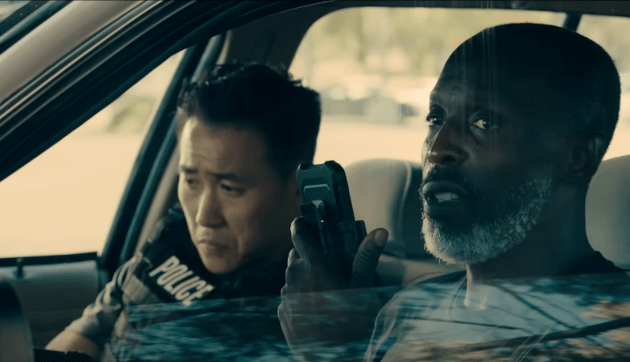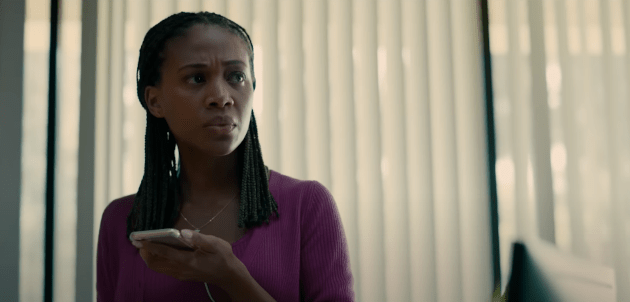Bank heists have long been a familiar premise in movies. However, in Breaking (2022) this set up takes a secondary role to more pressing matters. Directed by Abi Damaris Corbin (who also cowrites with Kwame Kwei-Armah), this examines the true-life tale of Brian Brown-Easley, a Marine war veteran who attempted to rob a Wells Fargo bank in Atlanta in 2017. When we look at the details of the robbery, we discover that Brown-Easley’s actions were about more than just money. The narrative digs into his background, revealing a life full of mistreatment and desperation. When a person feels like no one is listening to them, they may make irrational decisions to be heard. This is the story of a soul going to extreme lengths to be seen.
It’s a tragic reality: those who have served in the military have not had sufficient support once they return to civilian life. Just recently, actor/comedian Jon Stewart led a very public campaign to help pass the Pact Act, which gives assistance to veterans exposed to toxic chemicals. These are people who have given their lives to their country, and yet we see instance after instance of them not getting the help they deserve. That is what happened to Brown-Easley. Loopholes and excessive red tape caused the Department of Veteran Affairs (aka “the VA”) to withhold his financial assistance. This forced Brown-Easley to near poverty. Opening scenes show him close to living on the street. Unable to afford transportation, he walked along highways to get around. He stayed at shabby motels and spoke to his daughter and ex-wife on pay-per-use cell phones.

The mental and financial stress would eventually lead Brown-Easley to walk into that bank with a note saying that he had a bomb. But the twist is that he didn’t want the bank’s money, but for the VA to return what was owed to him. The situation gets sadder once we discover that the VA only owed him $892 (also the original title of the film). Much of the runtime takes place within the bank, where Brown-Easley (John Boyega) has barricaded himself with two employees: Estel (Nicole Beharie) and Rosa (Selenis Leyva). The central point of tension is between Brown-Easley making demands and the authorities trying to stop him. Things get interesting with the appearance of hostage negotiator Eli (the late great Michael K. Williams), who is also a veteran. Eli must balance his empathy for Brown-Easley’s plight while trying to prevent the situation from turning deadly.
The writing and direction peels away at Brown-Easley’s layers one at a time. Obviously, Rosa and Estel’s initial reactions are of panic and fear, but as they learn more about Brown-Easley, understanding starts to seep in. Right away, we see that he is not built for crime. Although the system has him acting out in bursts of frustration, he also apologizes for what he is doing, addresses everyone as “sir” or “ma’am,” and acts in ways that reveal his humanity. In a telling moment, Brown-Easley picks up a call from a distraught customer. Surprisingly, he treats the call as if he were an employee, even taking down a message to be passed along to a coworker. To drive this point home, Chris Witt’s editing also inserts several flashbacks of Brown-Easley during his stints in the service, his troubles with the VA, and his increasing emotional strain. Although these scenes help fill in his character, they come about abruptly – telling us information that we can already surmise – ultimately feeling unnecessary.
Boyega carries the film with his searing, powerful performance. We’ve known for a while just how talented he is, but here he commands the screen with his magnetism. His depiction of Brown-Easley balances an unpredictable nature with a painful vulnerability. In any given scene, Boyega can be unhinged, funny, and heartbreaking, and yet each exists within a believable, well-rounded character. Through his interactions, Boyega allows us to peek inside Brown-Easley’s mindset. He commands the screen in a way eerily like Denzel Washington, exuding both helplessness and authority. It would be interesting to view Boyega’s work here and Washington’s in John Q (2002) side by side and see how the two performances reflect and contrast.

That’s not to say that Boyega is the only good acting showcase we get. His central role is amplified by a cast all working at peak level. Beharie and Leyva are equally convincing as the bank workers, trapped between a rock and a hard place. Where Rosa is petrified at Brown-Easley’s every movement, Estel is quicker on her feet, trying to figure out a way to escape. But the best scenes are – without a doubt – between Brown-Easley and Michael K. Williams’ negotiator. The two are separated by age and occupation, but they share similar backgrounds. Eli uses this information to build a bridge between them. Williams proves yet again his skill in creating a character more complex than we would first assume. Eli is not just a seasoned, experienced cop, but a fleshed-out person standing in front of someone not too different from himself. Outside of some really bad turns, the two could have shared the same path in life. Seeing Michael K. Williams – in one of his final on-screen performances – just reminds us of the tragedy of his untimely passing.
Some of the best stories involve characters pushed to the brink, because it crystallizes their motivations with intensity and urgency. Brian Brown-Easley should’ve never been pushed to a point where he had no choice but to break the law, but by doing so he brought attention to an issue still relevant today. The craftsmanship may have its bumps and awkward steps, but there is no denying that the production delivered something vital. The film opens a discussion that goes beyond the limits of a movie theater. All Brian Brown-Easley wanted was to be heard, and through the power of cinema, he has.
Final Grade: B+
The post Film Review – Breaking written by Allen Almachar appeared first on The MacGuffin: Film and TV Reviews, Interviews, Analysis.



